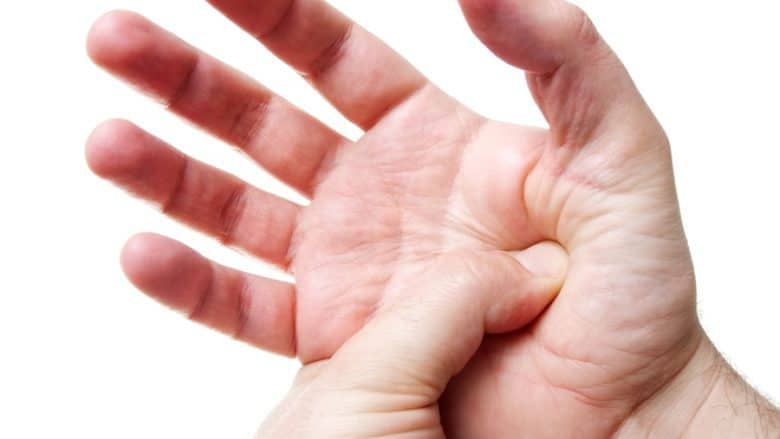
Acupressure points help Rose:
Rose’s head feels full and aches down into her right eye. She tries a quick relaxation exercise, but it doesn’t help. Then, she remembers acupressure.
Feeling with her thumbs across the base of her skull she finds tender spots: one on each side. She presses firmly, the pain intensifies and shoots up into her forehead and eye. She continues firm pressure for about a minute, then feels a release as the pain eases.
Her headache is gone.
What is Acupressure?
Acupressure is a traditional Chinese medicine technique based on the same idea as acupuncture. Its technique uses pressure on specific body points by means of a finger, hand, elbow, or various devices versus thin needles as in acupuncture.
It is based on the idea that when you are stressed, ill, or injured the flow of your life energy can become unbalanced, depleted, or congested. Acupressure reestablishes the healthy flow of life energy.
It deserves a place in your personal first aide kit because it is effective for a wide range of conditions including musculoskeletal pain and tension, headaches, depression, anxiety, sleep problems, and nausea.
A simple energy healing technique, it is easy to learn and is always at your finger tips.
What are Acupressure Points?
Ancient Dolls with Acupressure Points
Acupressure points, also called “gates,” are places on your body that are especially sensitive to bioelectrical impulses. They act as subtle portals that open or close to adjust the flow of life energy (called “chi” or “qi” in China and “ki” in Japan).
Life energy flows throughout your body in an invisible web of streams called “meridians.”
Much like the vast flow of waterways that nourish the earth or the blood that flows through vessels in your body; these energy streams empty into one another, connecting and nourishing organ systems and the interior and exterior body.
The acupressure points and meridians were discovered, numbered, and mapped more than 5,000 years ago in China. More recently, western science validated this human energy system using sensitive electrical devices as well.
How Do You Use Acupressure Points?
Generally, the subjective report of the person receiving acupressure is the best guide to finding the right spot and for how much pressure to apply to the point.
Acupressure practitioners use a variety of techniques for applying pressure. For example, some use firm pressure while rotating in a tight circular motion, while others use steady firm pressure.
Here we use steady firm pressure as it is the most fundamental method.
Acupressure Steps:
- Locate the point. Refer to an acupressure chart for the location of the point(s) related to your concern. Then, feel for a spot in the area that is particularly tender or sensitive. The right point generally announces itself through its tenderness.
- Gradually apply pressure perpendicular to the skin. The goal is to apply enough pressure to get results without causing unnecessary pain. “If it hurts, it should ‘hurt good.’ If some soreness cannot be felt, the pressure is probably not enough,” say Herriett Beinfield and Efrem Korngold in Between Heaven and Earth.
- Breathe deeply as you hold the pressure steady for a few minutes or until the pain eases or you feel a release. If it hurts “too much” ease the pressure until you find the right balance.For an extra boost, imagine that you are breathing healing energy into the painful area, recommends Michael Read Gach in Acupressure’s Potent Points.
- Gradually release the pressure and finish with a light soothing touch.
4 Acupressure Points to Know
- For Headache: GB 20 – Located below the base of the skull, in the hollow between the two neck muscles. These are the points that Rose used in the example above.
- For Headache: LI 4 – Located in the webbing between the thumb and index finger at the highest spot of the muscle when the thumb and index finger are brought close together.
- For Nausea: P6 – Located about two inches (3 finger widths) above the crease of the wrist.Numerous studies find that acupressure on this point is just as effective as anti-nausea drugs, according to the Mayo Clinic Book for Alternative Medicine.
- For Anxiety and Spiritual Support: GV 24.5 – Located just above the bridge of the nose and between the eyebrows. Enhances inner awareness when done lightly for a few minutes.
Key Points for Acupressure Points
Acupressure deserves a place in your natural healing first aide kit because it is effective for a wide range of conditions. It doesn’t work every time, but neither do drugs.
See a health practitioner for severe discomfort. Consult with an acupuncturist if pregnant as some points should not be used during pregnancy.
Most importantly, try at least one of the acupressure points above to see what it can do for you.
Sources and Resources
Bauer, Brent (ed.), Mayo Clinic Book of Alternative Medicine (New York: Time, Inc., 2007).
Becker, Robert and Selden, Gary, The Body Electric: Electromagnetism and The Foundation of Life (New York: Morrow, 1985).
Beinfield, Harriet and Korngold, Efrem, Between Heaven and Earth: A Guide to Chinese Medicine (New York: Ballantine Books, 1991).
Gach, Michael Reed, Acupressure’s Potent Points: A Guide to Self-Care for Common Ailments (New York: Bantam, 1990).
